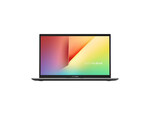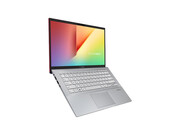Asus VivoBook S14 S431FA-EB156T
Specifications

Price comparison
Average of 2 scores (from 3 reviews)
Reviews for the Asus VivoBook S14 S431FA-EB156T
Source: Gogi.in
 Archive.org version
Archive.org versionIf you travel a lot and use a laptop while traveling and looking to buy a new one then check out the ASUS VivoBook S14 S431F, this ultra portable laptop is available in exciting colour options.
Single Review, online available, Short, Date: 12/03/2019
Source: Think Digit
 Archive.org version
Archive.org versionDespite its few shortcomings, it’s not a bad choice by any means. The VivoBook S431 is ideal for everyday computing, online video playback, and heavy web browsing. What’s more, the battery will last quite a long while too (though not as long as the VivoBook X403). Even if it suffers from a mild identity crisis, the Asus VivoBook S431 is a fine choice for students and working professionals alike. Do yourself a favour and buy it in a colour that’s not as plain and boring as the Transparent Silver that we got.
Single Review, online available, Long, Date: 11/01/2019
Rating: Total score: 68% price: 71% performance: 61% workmanship: 70%
Source: India Today
 Archive.org version
Archive.org versionAfter going through all the parameters, it's safe to say the new Asus VivoBook S14 431 is a good midrange laptop that will suffice for most casual laptop users looking to buy a laptop under Rs 60,000. The laptop performs daily tasks well. The lightweight and ergonomic build, which now gets a modern design refresh, should keep the fashion-conscious happy. The battery life is still average and Asus could have done something to offer at least an 8-hours battery life. And in late 2019, it could have made sense to offer a 10th Gen or at least a 9th Gen Intel processor.
Single Review, online available, Medium, Date: 10/18/2019
Rating: Total score: 80%
Comment
Model:
The Asus VivoBook S14 S431FA-EB156T is an unconventional take on daily computing, with a unique color-blocking design that expresses the uniqueness of this laptop. Its narrow bezel design not only gives users an immersive viewing experience, but makes the VivoBook S14 more compact and portable so they can take it wherever they go. As for the design, the VivoBook S14 has five striking discovery-inspired color blocking styles. The VivoBook S14 is built on the positive vibes generated by the colors of the previous generation. The colour options available are Moss Green, Punk Pink, Cobalt Blue, Gun Metal and Transparent Silver. These latest color options and unique finishes highlight the intricate and detailed designs of the VivoBook S14. Aside from that, the color-blocking side accents give it a svelte look, and additional design elements include twill-inspired vents for the speakers and cooling system. As for the display, the new four-sided NanoEdge design gives the VivoBook S14 a frameless, almost-bezel-free display with vast amounts of screen area and extremely immersive visuals, perfect for work or play. The panel is a 14” Full-HD display with a 6.3mm thin bezel, an 86% screen-to-body ratio and a 178-degree wide viewing angle.
The VivoBook S14 has the tools to help users every step of the way. With an Intel Core i5-8265U processor, 8 GB of DDR3-2133 RAM, 512 GB of SSD storage and an Intel UHD Graphics 620 GPU at their disposal, they are ready for what lies ahead, for example productive multitasking. Hands-free facial login means only the user can log in to their VivoBook S14. Advanced biometrics work seamlessly with Windows Hello, allowing them to wake their laptop and log in with a simple look. The VivoBook S14 makes audio sound better. It features a Harman-Kardon certified sound system for high-quality detailed audio that is second to none. For connectivity, it has Intel Wi-Fi 6 with Gig+ (802.11ax) that delivers super-fast networking speeds for faster large file transfers, responsive online gaming and super-smooth video chats. The VivoBook S14 has a range of features designed to keep users productive all day long, including battery charging. The fast-charge feature can help recharge a low battery level to 60% in just 49 minutes. In conclusion, the Asus VivoBook S14 S431FA-EB156T is an ultraportable mid-range laptop with a good set of hardware specifications. It does not only look good, but performs well, too. It is a decent choice for students and working professionals who work on the go.
Hands-on article by Jagadisa Rajarathnam
Intel UHD Graphics 620: Integrated GPU (GT2, 24 EUs) found on some Kaby-Lake-Refresh CPU models (15 W ULV series). Technically identical to the previous Kaby-Lake GPU called HD Graphics 620.
Modern games should be playable with these graphics cards at low settings and resolutions. Casual gamers may be happy with these cards.
» Further information can be found in our Comparison of Mobile Graphics Cards and the corresponding Benchmark List.
i5-8265U: Whiskey Lake based low power quad-core processor (technically identical to Kaby Lake but produced in a further improved 14nm++ process). The four cores are clocked between 1.6 and 3.9 GHz (Turbo Boost) and support HyperThreading.» Further information can be found in our Comparison of Mobile Processsors.




